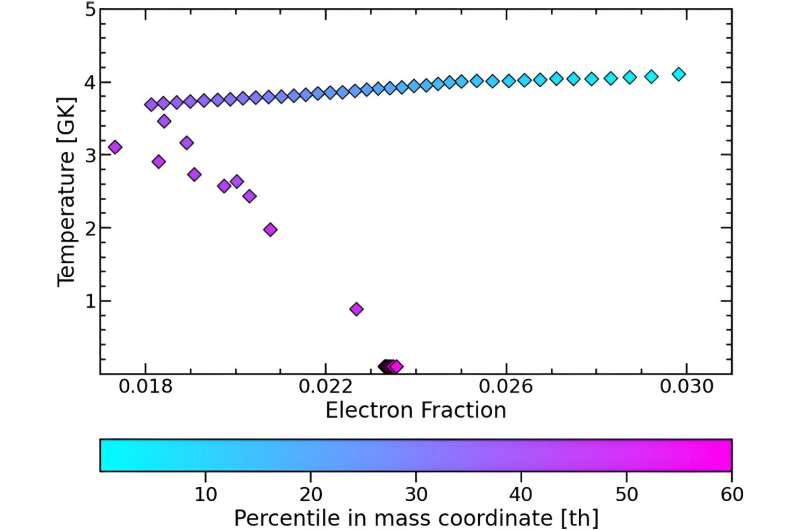This article has been reviewed according to Science X's editorial process and policies. Editors have highlighted the following attributes while ensuring the content's credibility:
fact-checked
peer-reviewed publication
proofread
Researchers discover alternative cosmic source of gold

Dr. Shing Chi Leung, SUNY Poly assistant professor of physics, in collaboration with Mr. Chun-Ming Yip, Dr. Ming-Chung Chu and Dr. Lap-Ming Lin, from the Chinese University of Hong Kong, have discovered that the explosion of a low-mass neutron star can be the alternative cosmic source for lanthanides and other heavy elements, including precious metals such as gold and platinum. Their study has been published in The Astrophysical Journal.
Neutron stars are the evolutionary end points of stars with a mass between 10 to 25 times that of the sun. After the final explosion, the star leaves behind a compact object with a mass comparable to the sun, and a diameter of about 20 km (the size of Manhattan). Such a compact object is stable enough to exist alone. But in a binary neutron star system, the interaction with the companion neutron star can trigger something dramatic.
Traditionally, when two neutron stars are close enough, they merge and collide. This process is the major source of lanthanides and heavy elements in the universe. The collision can create the condition (known as the r-process) for the synthesis of these elements.
The merger event was recently observed for the first time in 2017. However, it is highly uncertain if this channel alone is sufficient to explain the heavy elements in the cosmic scale.
The team noticed that even without direct collision, the primary neutron star can lose mass to its companion neutron star by tidal force. Theoretical models expect that after shedding sufficient mass, the star becomes unstable, and it triggers uncontrolled pulsation and the later explosion.
For their study, the team investigated if this channel can synthesize comparable heavy elements as the merger channel. There are very few previous studies of this process because the modeling is computationally challenging. It involves calculating very extensive nuclear reactions and accounting for the extreme environment around a neutron star.
The team has successfully overcome the numerical barrier and simulated how these explosions take place. To make sure the chemical elements are correctly calculated, they used a large nuclear network of more than 3,000 isotopes with the most updated microphysics. Their new results confirm that the individual low mass neutron star is unstable, and it can explode. The chemical composition of the ejecta closely resembles the solar composition, especially in heavy elements. This suggests that this scenario could be another important method to explain the chemical element distribution in the universe.
This study sheds light on one of the fundamental questions about the universe: where all the chemical elements come from, and how did the universe evolve from only hydrogen and helium to a diversity of 118 elements. Lanthanides have close relations with modern technology. For example, neodymium is the main ingredient for manufacturing strong magnets. Heavy elements including precious metals, i.e., gold and platinum, are also abundantly produced by this channel.
The team will continue to investigate the observational prospect of the explosion and improve the input physics to make the simulations more realistic.
More information: Chun-Ming Yip et al, R-process Nucleosynthesis of Subminimal Neutron Star Explosions, The Astrophysical Journal (2023). DOI: 10.3847/1538-4357/acf570
Journal information: Astrophysical Journal
Provided by Suny Polytechnic Institute





















